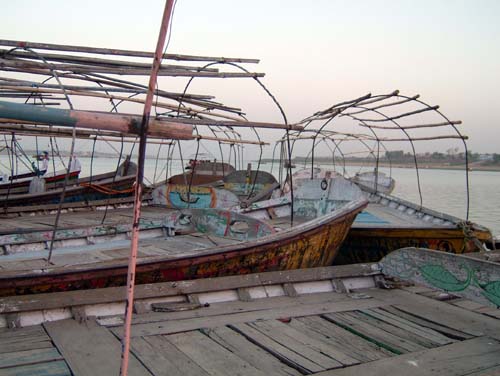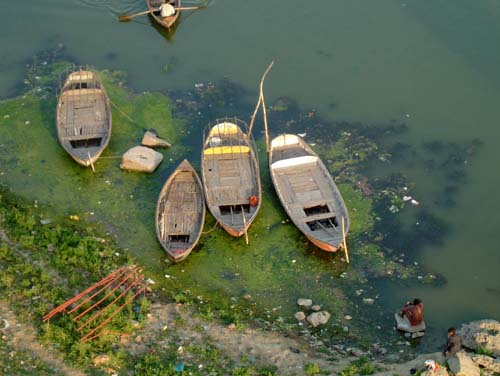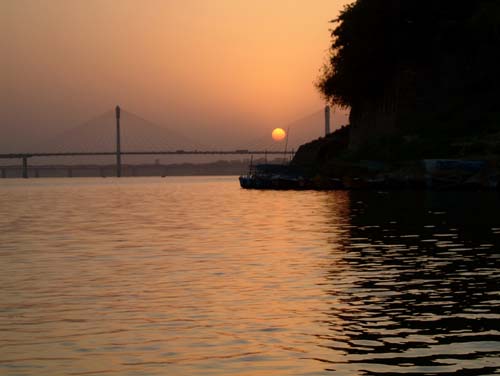Dec 29, 2025
Dec 29, 2025
Visiting Allahabad a century ago, the American humorist Mark Twain experienced the unique singularity of the India tradition and its utter incomprehensibility. India has always fascinated both Indians and foreigners alike by its immutable religiosity and strange mysticism. It creates an aura of inaccessible mystery that is hard for any westerner to shake off. Many British writers from Rudyard Kipling to E.M. Forster had much to say about the discomfort and surprise India gave them, but yet the country captivated them. Kipling for instance hated Allahabad but was fascinated by Professor Alec Hill's house, called Belvedere, where he lived. Later he chose the bucolic surrounding of the house as the locale for his famous Rikki-Tikki Tavi tale, the story of a brave and loyal mongoose who cunningly devised strategies to kill all the poisonous snakes in the garden and save its inhabitants from harm.

Though Allahabad has a hoary past it rarely figures on the itinerary of an ardent traveler. It does not compete with touristy places like Goa or Pondicherry, nor does it offer the hustle and bustle of Delhi or Bombay. Allahabad has an old-fashioned, primordial charm of its own. It is for people who are fired by a fervent wish to find the quintessential or quaint India. It is for those who are not worried about the inconveniences of traveling or living in new and often inhospitable places.
Once the capital of United Provinces, and later the center of political revolt against the British Empire, Allahabad embodies a long religious and intellectual tradition. In the recent past the city has attracted great revolutionaries, storytellers, poets and Bollywood stars such as Jawaharlal Nehru, Lala Lajpat Rai, Chandrashekhar Azad, Bhagat Singh, Kipling, Amitabh Bacchan and others. Many old timers feel that Allahabad is losing both its Mughal and British charm, but its primeval lure as a center of pilgrimage continues to survive.

There is an abiding quality even in its history. The ancient name of Allahabad was Prayag Raj or the place of great sacrifice. It is said that Brahma himself offered his first sacrifice at Prayag after creating the world. In 1583, the Mughal emperor Jalaluddin Akbar gave Prayag Raj the name of Allahabad or the City of God. It is undoubtedly a city of god where all major religions of the world can be found. It is possible to see an ancient temple, a stucco-white mosque, a stone cathedral bustling with life.
Prayag Raj lies some six hundred kilometers southeast of Delhi at the confluence of three great rivers of north India'Ganga, Yamuna and Saraswati. The confluence makes it an important pilgrimage center, giving rise to many religious festivals such as the Magh mela and the Kumbh mela. Since the festival takes place in the month of Magh, that is January-February, it is called Magh mela. The Makar Sankranti or Divine Good marks the beginning of the Magh mela and Puranmasi or the full moon its end. This festival brings millions of people from all over India to Prayag and forces the Allahabad Municipal Corporation to create an entire new city for two months on the banks of these rivers.
Allahabad stands in the middle of the Doab region where hundreds of agricultural communities rely on rain or river water for irrigating crops. Water, therefore, becomes the most important aspect of life. It acquires the force of a central symbol that purifies, heals and removes the darkness from the spirit. The image of the water is further woven into the notion of a huge confluence. At Allahabad the reality of the confluence is profound. It turns the water into a vast sea that sometimes takes nearly half an hour to cross. Though overloaded boats overturn and some of its banks are infested with crocodiles, there hazards do not deter the pious. They come here regularly to bathe in its divine waters seeking benefits or moksha, carrying a faith without fear.

The ancient Sanskrit literature of India has always attached great significance to rivers and created a whole body of religious myth around it. The places where rivers meet have obvious divine connotations. The Rigveda, The Ramayana and The Mahabharata give a special place to Prayag as the center for saints and sages. The Puranas speak of the merits gathered by any man who makes a pilgrimage to Tirtharaj Prayag. The Matsya Purana clearly lays down different methods of worship, religious observance and spiritual preparedness for the dutiful. Kalidasa in The Raghuvamsa, Canto XIII, poignantly captures the kinetic energy of the confluence. The Rigveda too speaks of the magic of River Ganga. One verse from The Prayag Mahatamya, extols the virtues of the confluence in the following manner:
Shines in its glory the king of shrines,
Two noble-born maidens Ganga and Yamuna,
Daughters of ascetic Bhanu and the sun
Wave their soft white and blue Yak tails
The imperishable holy Banyan tree becomes
The azure colored royal canopy over the head of Prayag.
True to the distinctive woolly white of the Ganga and the placid blue of the Yamuna the ancient Puranic bard builds the conceit of commingling of the two rivers that are represented as two beautiful maidens. The iconography of the rivers carries the beauty and elegance of the feminine form that helps us to understand some aspects of Indian aesthetics.
Triveni, as the confluence is aptly called, brings forth the image of a third river, the mythical Saraswati, emerging from below the earth, meeting the braided Ganga and Yamuna, knitting them further with its own braid. It is impossible to guess when Saraswati last flowed and when it disappeared, or if it still flows. It is a Rigvedic river that supposedly dried up in the desert centuries ago, but even today its symbolic significance is no less. It is the ambitame naditame devitame sarasvati (or the best mother, best river, best goddess) and it is possible to find all the life spans or ayus along its banks. Ancient Indian texts help to conjure up the image of Saraswati and keep alive the witchery of a mystical tripartite dialogue of an eternal cosmic flow.
The devout believe that it is possible to hear the mystic sound Om if one were to stand quietly at Triveni Sangam. Even a day is enough to bring lasting benefits, but if one were to stay for a month on its banks it would bring merits that may last for many lifetimes. Some are convinced that if they were to bathe in its pure water, abstain from eating cereals and recite religious shlokas they could earn the title of Kalpbasis or those who have resolved to abide by the sacred Hindu principles.
A visit to Allahabad has never been considered an ordinary visit. Celestial beings and great minds saw it as a pilgrimage. Lord Brahma chose Prayag to perform the Ashwamedha Yajna or the horse sacrifice. Lord Buddha is said to have stayed for three days here to preach his enlightened ideas. Priyadarshin Ashoka preached his philosophy of compassion at Prayag that later spread throughout his empire from Kalinga to Kabul. Harshavardhana visited the city every six years to participate in its religious celebrations. The famous Chinese chronicler Huien Tsang wrote that he stayed in King Harshavardhana's camp for forty days and witnessed the spending of all the state savings on Bhikkus, monks and sadhus. Huien Tsang stated that the King felt pride and satisfaction upon emptying his treasury at Prayag.
Apart from Huien Tsang other international travelers such as Megasthenes, Pliny and Al Beruni also visited Prayag and witnessed the spiritual concord of the Magh mela. Kabir and Tulsidas definitely stayed near the holy confluence and preached to the devotees. Guru Nanak and Guru Govind Singh were the first and the last of the Sikh gurus who came here underscoring its importance. Emperor Aurangzeb held a special durbar at the Allahabad fort and witnessed the celebrations at Sangam. It is believed that on that occasion the Emperor issued a farman or royal decree through which he conferred a jagir of three villages on the pujari of Someshwar Nath Mahadeo temple and gave away one thousand gold mohurs and ten tolas of gold to him.
The festival of Magh mela is rooted in history and the changing rhythms of the seasons. After Makar Sankranti comes Amawasya or the new moon of Magh. This is followed by Basant Panchami or first day of the spring season which in turn ushers in the Achala Saptmi, Ekadashi and finally Puranmasi or the full moon when the religious assembly breaks up to meet again next year. Once in twelve years the Magh mela swells into gigantic proportions and is referred to as the Kumbh mela or the Great Pitcher Festival.
The kumbh is considered the biggest religious gathering in the world. Demographers have recorded that three million devotees bathed on Amavasya day at Allahabad in 1906, while seventy million entered its waters in 2001. The Ardh Kumbh or Half Pitcher Festival comes midway between the two kumbhs and it is an equally huge festival. Since it is impossible for all the sadhus to attend the Magh mela, representatives of each order establish their camps with their flags flying atop their tents. These camps are called akharas. The akharas are established according to religious hierarchy.
The Naga Goshains, the original followers of Lord Shiva, take precedence over all others. Both the Nagas and the Junas or Niranjanis go naked, smearing their bodies with ash, but coming from affluent communities they do not beg for a living. Their matted hair and religious deportment give the mela its special charm. These two communities are followed by the Bairagis or the wandering sadhus. They are the nomadic minstrels singing devotional songs and sermonizing on issues of common concern such as marriage, childbirth, family and community. If you were to visit Mutthiganj, Kydganj or Daragunj in Allahabad you would see some exotic akharas of various sects such as Digambaris, Udasis, Chotta Panchayatis, Bara Panchayatis, Sanyasis and Ramanujis and observe their striking life styles.
During important festivals colorful processions on foot and on elephants meander towards the ghats. There is a healthy competition between different akharas or monastic orders, each claiming to carry the authentic spirit of the festival. At times a stand off between different akharas may result in a stampede, but it is often settled amicably. In 1906, for example, the English cavalry was called to resolve the quarrel between the Nirbani and Nirmoni Digambari over the question of precedence in the procession.
The yearning for self-purification draws the devout to Allahabad. Along its banks this religious yearning takes on a business-like urgency. Most Hindus believe that shaving the head is the first act of purification. Those who shave their heads on the banks of the Ganga will enjoy heavenly bliss for those many years as the number of hair on their head. Men and women, therefore, bathe in the river and then come out making a sankalp or a determination. They repeat their determination, pour milk and throw flowers in the river. Sometimes a priest helps with a nominal fee. A rich devotee may offer a cow, horse or an elephant to the priest while a poor disciple may give a few rupees. Some also conduct a pinda dan, or ritual for the peace of ancestors where they offer rice cakes and fresh flowers to the river and then feed the Brahmins.
Most modern tourists like Twain or Kipling are overawed by the religious impulse that propels multitudes upon multitudes of people to undertake the incredible journey to the Kumbh festival in Allahabad. They, like Mark Twain, wonder whether the religious impulse is born out of love or fear and finding no answer become more intrigued by its religiosity. Whatever discomforts await you in the raw and dusty city of Allahabad a short visit during kumbh mela will not only surprise you but help you understand the inimitable India.
25-Aug-2007
More by : Mukesh Williams